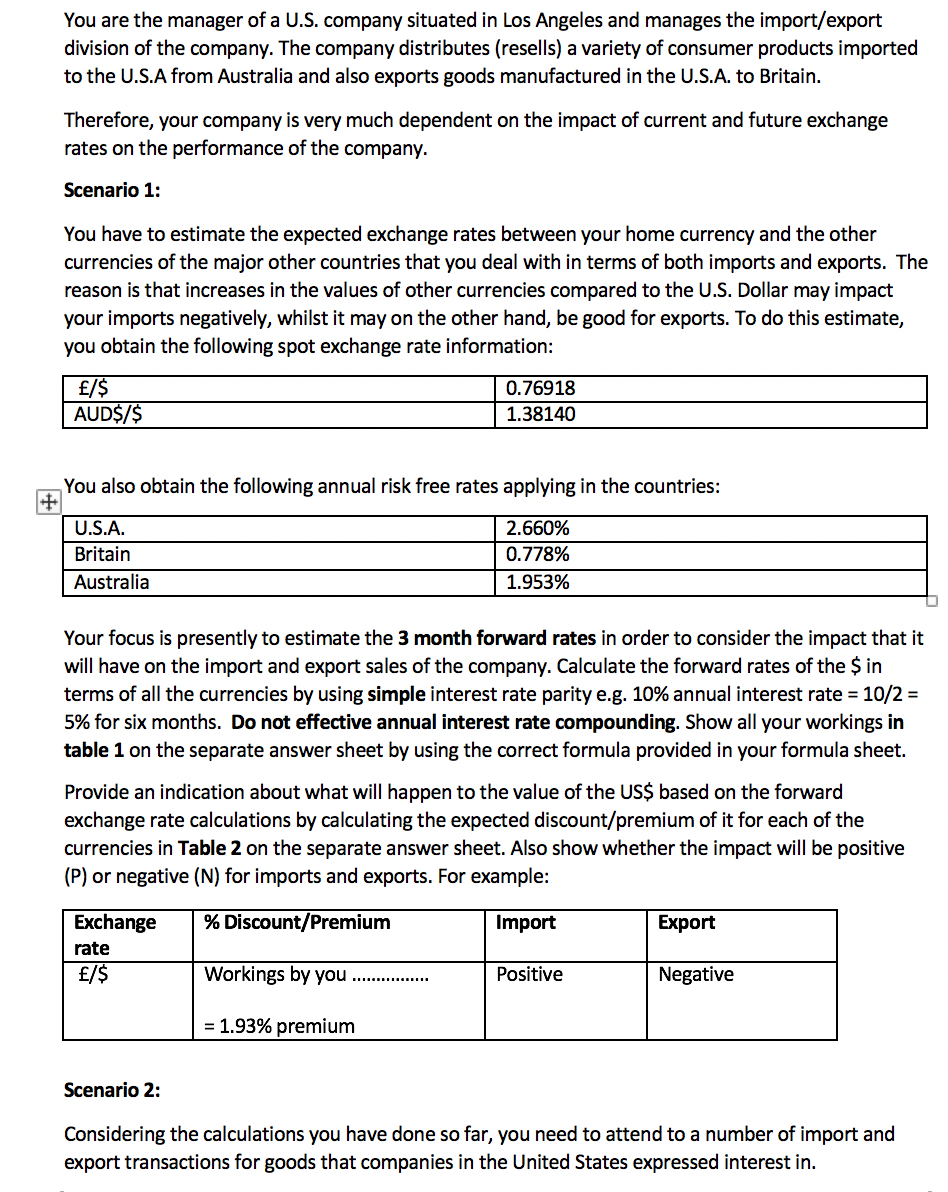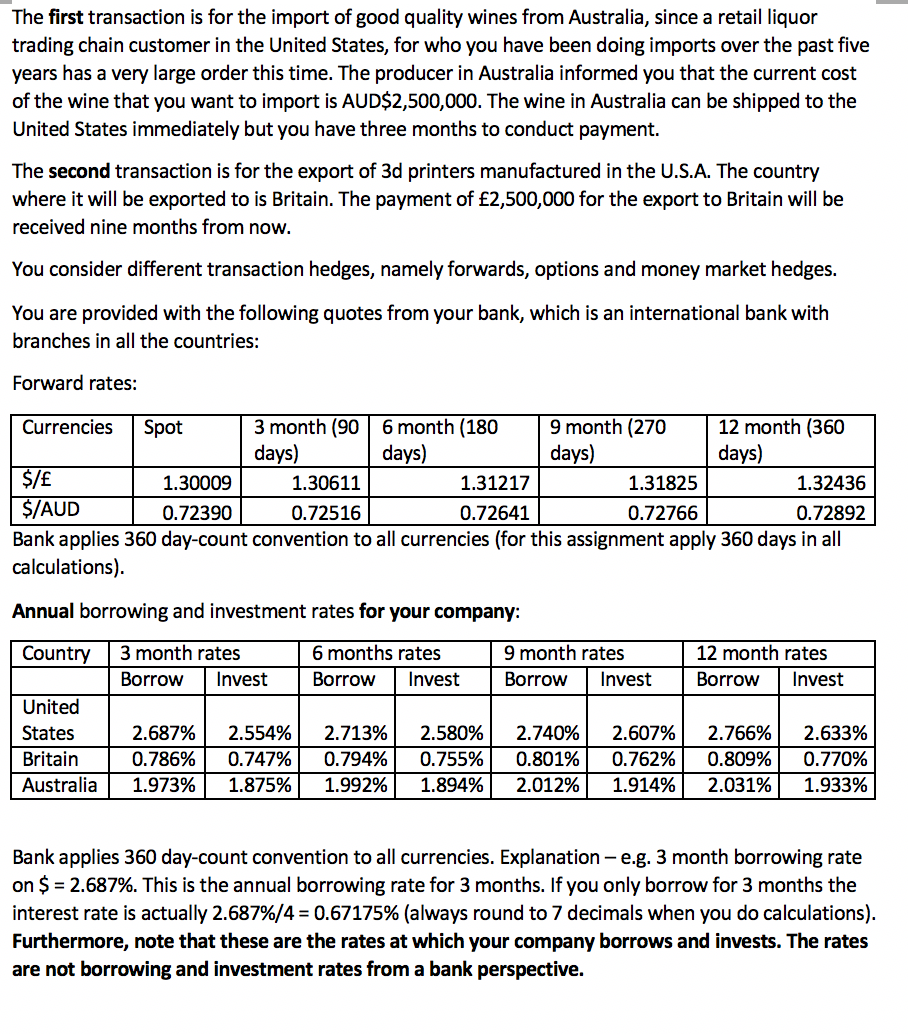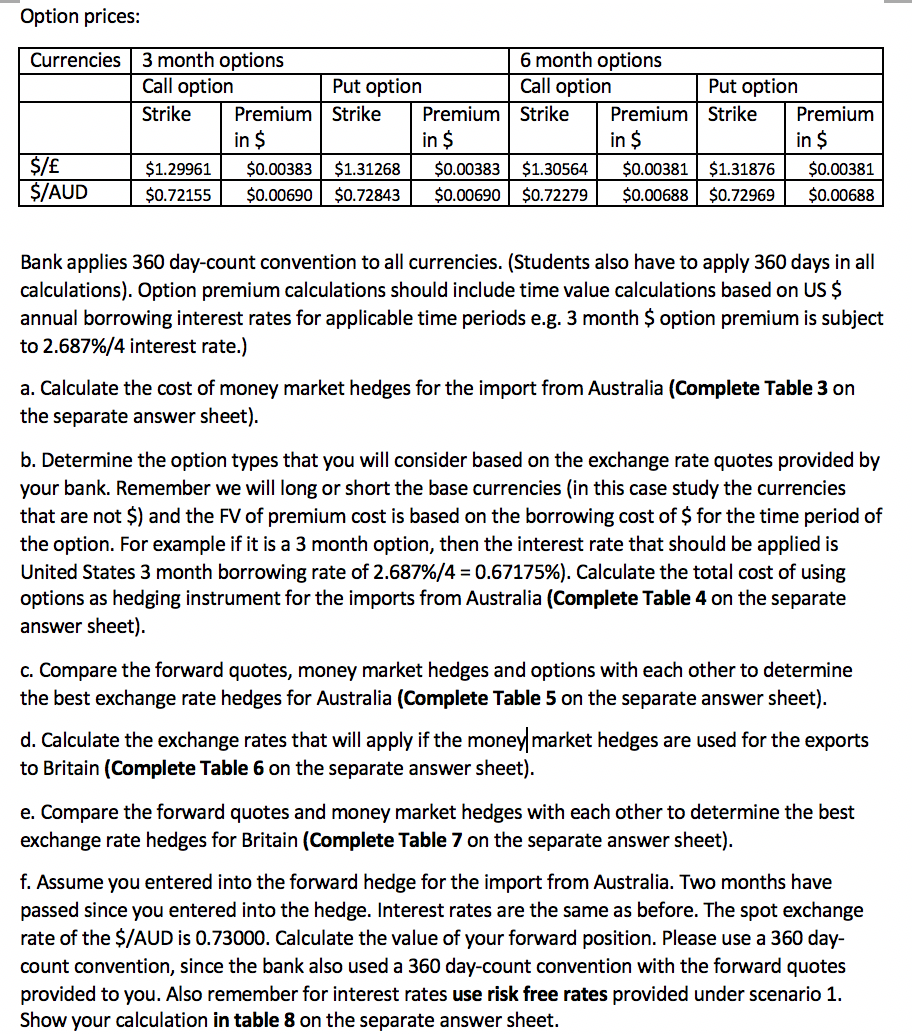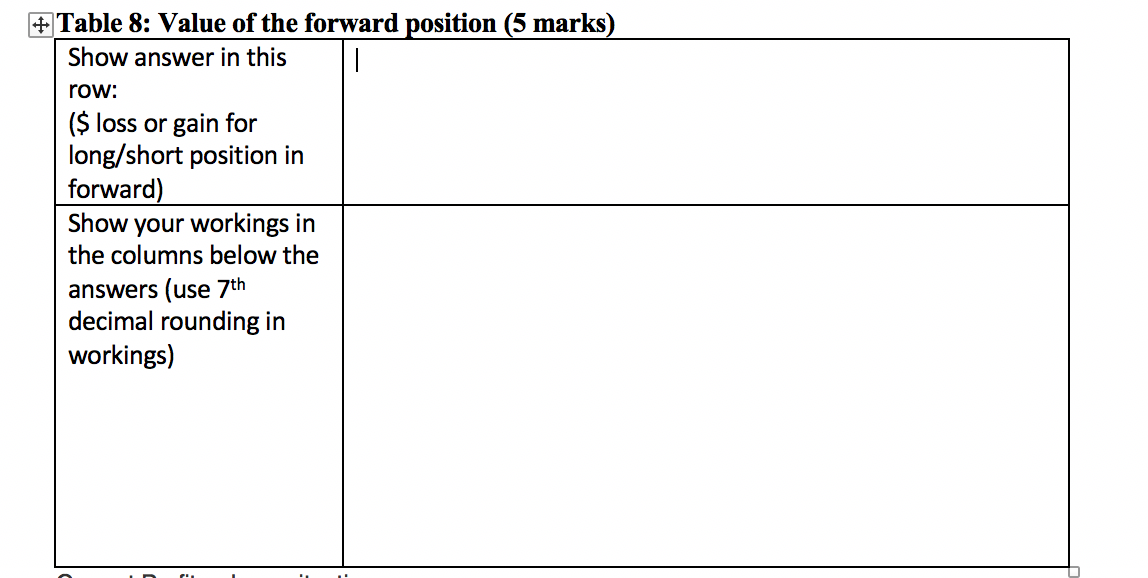Answered step by step
Verified Expert Solution
Question
1 Approved Answer
can I ask for question F? The answer should fill in at the table 8 You are the manager of a U.S. company situated in



 can I ask for question F? The answer should fill in at the table 8
can I ask for question F? The answer should fill in at the table 8
You are the manager of a U.S. company situated in Los Angeles and manages the import/export division of the company. The company distributes (resells) a variety of consumer products imported to the U.S.A from Australia and also exports goods manufactured in the U.S.A. to Britain. Therefore, your company is very much dependent on the impact of current and future exchange rates on the performance of the company. Scenario 1: You have to estimate the expected exchange rates between your home currency and the other currencies of the major other countries that you deal with in terms of both imports and exports. The reason is that increases in the values of other currencies compared to the U.S. Dollar may impact your imports negatively, whilst it may on the other hand, be good for exports. To do this estimate, you obtain the following spot exchange rate information: /$ AUD$7$ 0.76918 1.38140 You also obtain the following annual risk free rates applying in the countries: + U.S.A. Britain Australia 2.660% 0.778% 1.953% Your focus is presently to estimate the 3 month forward rates in order to consider the impact that it will have on the import and export sales of the company. Calculate the forward rates of the $ in terms of all the currencies by using simple interest rate parity e.g. 10% annual interest rate = 10/2 = 5% for six months. Do not effective annual interest rate compounding. Show all your workings in table 1 on the separate answer sheet by using the correct formula provided in your formula sheet. Provide an indication about what will happen to the value of the US$ based on the forward exchange rate calculations by calculating the expected discount/premium of it for each of the currencies in Table 2 on the separate answer sheet. Also show whether the impact will be positive (P) or negative (N) for imports and exports. For example: % Discount/Premium Import Export Exchange rate /$ Workings by you ........ Positive Negative = 1.93% premium Scenario 2: Considering the calculations you have done so far, you need to attend to a number of import and export transactions for goods that companies in the United States expressed interest in. The first transaction is for the import of good quality wines from Australia, since a retail liquor trading chain customer in the United States, for who you have been doing imports over the past five years has a very large order this time. The producer in Australia informed you that the current cost of the wine that you want to import is AUD$2,500,000. The wine in Australia can be shipped to the United States immediately but you have three months to conduct payment. The second transaction is for the export of 3d printers manufactured in the U.S.A. The country where it will be exported to is Britain. The payment of 2,500,000 for the export to Britain will be received nine months from now. You consider different transaction hedges, namely forwards, options and money market hedges. You are provided with the following quotes from your bank, which is an international bank with branches in all the countries: Forward rates: Currencies Spot 3 month (90 6 month (180 9 month (270 12 month (360 days) days) days) days) $/ 1.30009 1.30611 1.31217 1.31825 1.32436 $/AUD 0.72390 0.72516 0.72641 0.72766 0.72892 Bank applies 360 day-count convention to all currencies (for this assignment apply 360 days in all calculations) Annual borrowing and investment rates for your company: Country 3 month rates Borrow Invest 6 months rates Borrow Invest 9 month rates Borrow Invest 12 month rates Borrow Invest United States Britain Australia 2.687% 0.786% 1.973% 2.554% 0.747% 1.875% 2.713% 0.794% 1.992% 2.580% 0.755% 1.894% 2.740% 0.801% 2.012% 2.607% 0.762% 1.914% 2.766% 0.809% 2.031% 2.633% 0.770% 1.933% Bank applies 360 day-count convention to all currencies. Explanation - e.g. 3 month borrowing rate on $ = 2.687%. This is the annual borrowing rate for 3 months. If you only borrow for 3 months the interest rate is actually 2.687%/4 = 0.67175% (always round to 7 decimals when you do calculations). Furthermore, note that these are the rates at which your company borrows and invests. The rates are not borrowing and investment rates from a bank perspective. Option prices: Currencies 3 month options Call option Put option Strike Premium Strike Premium in $ in $ $/ $1.29961 $0.00383 $1.31268 $0.00383 $/AUD $0.72155 $0.00690 $0.72843 $0.00690 6 month options Call option Put option Strike Premium Strike Premium in $ in $ $1.30564 $0.00381 $1.31876 $0.00381 $0.72279 $0.00688 $0.72969 $0.00688 Bank applies 360 day-count convention to all currencies. (Students also have to apply 360 days in all calculations). Option premium calculations should include time value calculations based on US $ annual borrowing interest rates for applicable time periods e.g. 3 month $ option premium is subject to 2.687%/4 interest rate.) a. Calculate the cost of money market hedges for the import from Australia (Complete Table 3 on the separate answer sheet). b. Determine the option types that you will consider based on the exchange rate quotes provided by your bank. Remember we will long or short the base currencies in this case study the currencies that are not $) and the FV of premium cost is based on the borrowing cost of $ for the time period of the option. For example if it is a 3 month option, then the interest rate that should be applied is United States 3 month borrowing rate of 2.687%/4 = 0.67175%). Calculate the total cost of using options as hedging instrument for the imports from Australia (Complete Table 4 on the separate answer sheet). c. Compare the forward quotes, money market hedges and options with each other to determine the best exchange rate hedges for Australia (Complete Table 5 on the separate answer sheet). d. Calculate the exchange rates that will apply if the money market hedges are used for the exports to Britain (Complete Table 6 on the separate answer sheet). e. Compare the forward quotes and money market hedges with each other to determine the best exchange rate hedges for Britain (Complete Table 7 on the separate answer sheet). f. Assume you entered into the forward hedge for the import from Australia. Two months have passed since you entered into the hedge. Interest rates are the same as before. The spot exchange rate of the $/AUD is 0.73000. Calculate the value of your forward position. Please use a 360 day- count convention, since the bank also used a 360 day-count convention with the forward quotes provided to you. Also remember for interest rates use risk free rates provided under scenario 1. Show your calculation in table 8 on the separate answer sheet. + Table 8: Value of the forward position (5 marks) Show answer in this | row: ($ loss or gain for long/short position in forward) Show your workings in the columns below the answers (use 7th decimal rounding in workings) You are the manager of a U.S. company situated in Los Angeles and manages the import/export division of the company. The company distributes (resells) a variety of consumer products imported to the U.S.A from Australia and also exports goods manufactured in the U.S.A. to Britain. Therefore, your company is very much dependent on the impact of current and future exchange rates on the performance of the company. Scenario 1: You have to estimate the expected exchange rates between your home currency and the other currencies of the major other countries that you deal with in terms of both imports and exports. The reason is that increases in the values of other currencies compared to the U.S. Dollar may impact your imports negatively, whilst it may on the other hand, be good for exports. To do this estimate, you obtain the following spot exchange rate information: /$ AUD$7$ 0.76918 1.38140 You also obtain the following annual risk free rates applying in the countries: + U.S.A. Britain Australia 2.660% 0.778% 1.953% Your focus is presently to estimate the 3 month forward rates in order to consider the impact that it will have on the import and export sales of the company. Calculate the forward rates of the $ in terms of all the currencies by using simple interest rate parity e.g. 10% annual interest rate = 10/2 = 5% for six months. Do not effective annual interest rate compounding. Show all your workings in table 1 on the separate answer sheet by using the correct formula provided in your formula sheet. Provide an indication about what will happen to the value of the US$ based on the forward exchange rate calculations by calculating the expected discount/premium of it for each of the currencies in Table 2 on the separate answer sheet. Also show whether the impact will be positive (P) or negative (N) for imports and exports. For example: % Discount/Premium Import Export Exchange rate /$ Workings by you ........ Positive Negative = 1.93% premium Scenario 2: Considering the calculations you have done so far, you need to attend to a number of import and export transactions for goods that companies in the United States expressed interest in. The first transaction is for the import of good quality wines from Australia, since a retail liquor trading chain customer in the United States, for who you have been doing imports over the past five years has a very large order this time. The producer in Australia informed you that the current cost of the wine that you want to import is AUD$2,500,000. The wine in Australia can be shipped to the United States immediately but you have three months to conduct payment. The second transaction is for the export of 3d printers manufactured in the U.S.A. The country where it will be exported to is Britain. The payment of 2,500,000 for the export to Britain will be received nine months from now. You consider different transaction hedges, namely forwards, options and money market hedges. You are provided with the following quotes from your bank, which is an international bank with branches in all the countries: Forward rates: Currencies Spot 3 month (90 6 month (180 9 month (270 12 month (360 days) days) days) days) $/ 1.30009 1.30611 1.31217 1.31825 1.32436 $/AUD 0.72390 0.72516 0.72641 0.72766 0.72892 Bank applies 360 day-count convention to all currencies (for this assignment apply 360 days in all calculations) Annual borrowing and investment rates for your company: Country 3 month rates Borrow Invest 6 months rates Borrow Invest 9 month rates Borrow Invest 12 month rates Borrow Invest United States Britain Australia 2.687% 0.786% 1.973% 2.554% 0.747% 1.875% 2.713% 0.794% 1.992% 2.580% 0.755% 1.894% 2.740% 0.801% 2.012% 2.607% 0.762% 1.914% 2.766% 0.809% 2.031% 2.633% 0.770% 1.933% Bank applies 360 day-count convention to all currencies. Explanation - e.g. 3 month borrowing rate on $ = 2.687%. This is the annual borrowing rate for 3 months. If you only borrow for 3 months the interest rate is actually 2.687%/4 = 0.67175% (always round to 7 decimals when you do calculations). Furthermore, note that these are the rates at which your company borrows and invests. The rates are not borrowing and investment rates from a bank perspective. Option prices: Currencies 3 month options Call option Put option Strike Premium Strike Premium in $ in $ $/ $1.29961 $0.00383 $1.31268 $0.00383 $/AUD $0.72155 $0.00690 $0.72843 $0.00690 6 month options Call option Put option Strike Premium Strike Premium in $ in $ $1.30564 $0.00381 $1.31876 $0.00381 $0.72279 $0.00688 $0.72969 $0.00688 Bank applies 360 day-count convention to all currencies. (Students also have to apply 360 days in all calculations). Option premium calculations should include time value calculations based on US $ annual borrowing interest rates for applicable time periods e.g. 3 month $ option premium is subject to 2.687%/4 interest rate.) a. Calculate the cost of money market hedges for the import from Australia (Complete Table 3 on the separate answer sheet). b. Determine the option types that you will consider based on the exchange rate quotes provided by your bank. Remember we will long or short the base currencies in this case study the currencies that are not $) and the FV of premium cost is based on the borrowing cost of $ for the time period of the option. For example if it is a 3 month option, then the interest rate that should be applied is United States 3 month borrowing rate of 2.687%/4 = 0.67175%). Calculate the total cost of using options as hedging instrument for the imports from Australia (Complete Table 4 on the separate answer sheet). c. Compare the forward quotes, money market hedges and options with each other to determine the best exchange rate hedges for Australia (Complete Table 5 on the separate answer sheet). d. Calculate the exchange rates that will apply if the money market hedges are used for the exports to Britain (Complete Table 6 on the separate answer sheet). e. Compare the forward quotes and money market hedges with each other to determine the best exchange rate hedges for Britain (Complete Table 7 on the separate answer sheet). f. Assume you entered into the forward hedge for the import from Australia. Two months have passed since you entered into the hedge. Interest rates are the same as before. The spot exchange rate of the $/AUD is 0.73000. Calculate the value of your forward position. Please use a 360 day- count convention, since the bank also used a 360 day-count convention with the forward quotes provided to you. Also remember for interest rates use risk free rates provided under scenario 1. Show your calculation in table 8 on the separate answer sheet. + Table 8: Value of the forward position (5 marks) Show answer in this | row: ($ loss or gain for long/short position in forward) Show your workings in the columns below the answers (use 7th decimal rounding in workings)
Step by Step Solution
There are 3 Steps involved in it
Step: 1

Get Instant Access to Expert-Tailored Solutions
See step-by-step solutions with expert insights and AI powered tools for academic success
Step: 2

Step: 3

Ace Your Homework with AI
Get the answers you need in no time with our AI-driven, step-by-step assistance
Get Started


